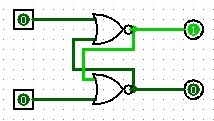Sequential Logic
The following building blocks, when combined with the ALU and other components, form the complete Hack computer system.
- The D Flip-Flop (DFF) forms the basis for all memory elements.
- The 1-Bit Register is used to construct larger memory units.
- RAM8 and the parameterized RAM are used for data storage.
- And the Counter is used as the program counter in the CPU, like a clock.
DFF
The DFF stores a single bit. On each positive edge of the clock signal, it updates its output q with the value of the input d. Here is a Logisim implementation showing how we can actually store information. From here on out, I will focus on just the Verilog though.
 |
|---|
| A flip-flop circuit storing a bit created in Logisim. |
module DFF(
input clk,
input d,
output reg q
);
always @(posedge clk) begin
q <= d;
end
endmodule
... Testing with GTKWave ...
1-Bit Register
The 1-Bit Register is a controllable DFF. It stores a single bit and updates its value when the load signal is high. The current state is continuously output.

module Bit(
input clk,
input in,
input load,
output out
);
reg state;
always @(posedge clk) begin
if (load)
state <= in;
end
assign out = state;
endmodule
... Testing with GTKWave ...
8-Register Memory (RAM8)
The RAM8 module is a small memory unit with 8 16-bit registers. It can store a value to a specified address when load is high, and continuously outputs the value at the current address.
module RAM8(
input clk,
input [2:0] address,
input [15:0] in,
input load,
output [15:0] out
);
reg [15:0] memory [0:7];
always @(posedge clk) begin
if (load)
memory[address] <= in;
end
assign out = memory[address];
endmodule
... Testing with GTKWave ...
n-Register Memory
This is a parameterized RAM module that can be instantiated with different sizes. It functions similarly to RAM8 but with a configurable number of registers. The $clog2(SIZE) determines the width of the address input based on the RAM size.
module RAM(
input clk,
input [$clog2(SIZE)-1:0] address,
input [15:0] in,
input load,
output [15:0] out
);
parameter SIZE = 16; // Default size, can be overridden
reg [15:0] memory [0:SIZE-1];
always @(posedge clk) begin
if (load)
memory[address] <= in;
end
assign out = memory[address];
endmodule
... Testing with GTKWave ...
Counter
The Counter is a 16-bit program counter for the Hack architecture. It can be reset to 0, loaded with a specific value, or incremented. This is typically used to keep track of the next instruction to be executed in the Hack computer.
module Counter(
input clk,
input reset,
input [15:0] in,
input load,
input inc,
output reg [15:0] out
);
always @(posedge clk) begin
if (reset)
out <= 16'b0;
else if (load)
out <= in;
else if (inc)
out <= out + 1;
end
endmodule
... Testing with GTKWave ...
"The $7 billion Ariane 5 rocket, launched on June 4, 1996, veered off course 40 seconds after launch, broke up, and exploded. The failure was caused when the computer controlling the rocket overflowed its 16-bit range and crashed. The code had been extensively tested on the Ariane 4 rocket. However, the Ariane 5 had a faster engine that produced larger values for the control computer, leading to the overflow." Digital Design and Computer Architetecture by Sarah and David Harris.
You can see why considering the counter and memory is important. And this is one of the reasons we moved on from 16 to 32 to 64 bits. If you have a 64 bit counter, and only ever increment it by 1, you may safely assume it will never overflow since, if your 4 GHz processor increments every single clock cycle, it will still take 146 years to overflow. So in practice: never. Assuming we use off-the-shelve ICs to build a bread board Hack computer. In reality, even this is based on several assumptions that do not apply to modern compute architectures. Having multiples cores, memory allocation optimization, multi-threading, ... I think all of these things break this calculus. That's why certain specialized applications require counters with even 128 bits.